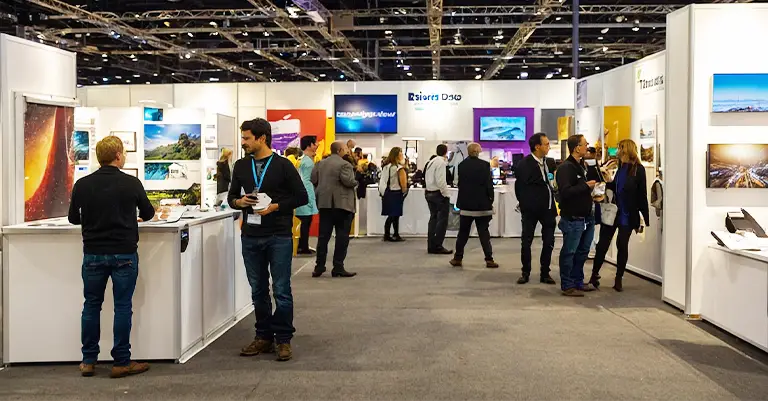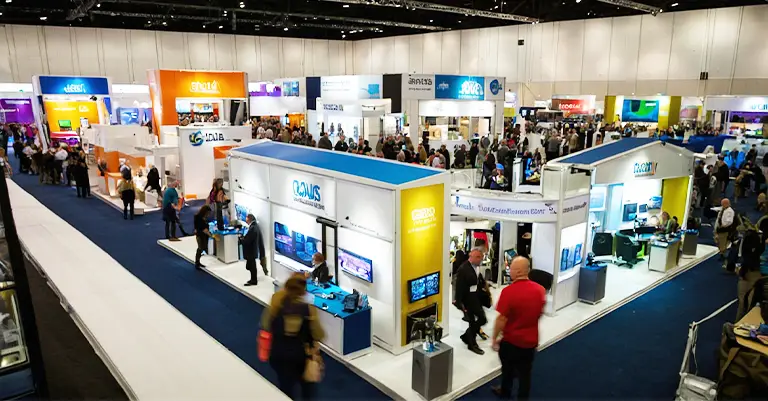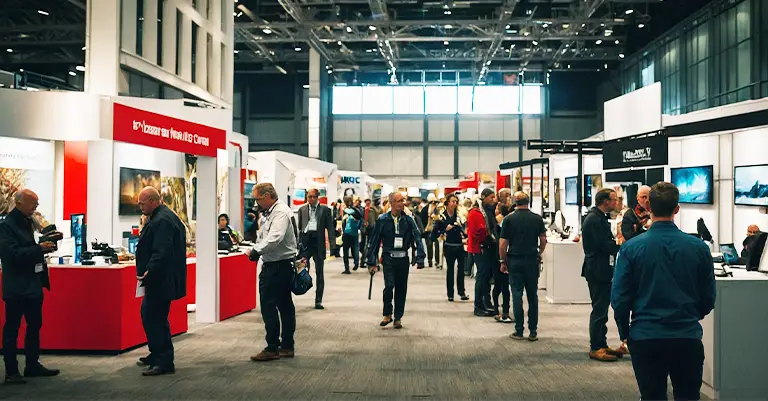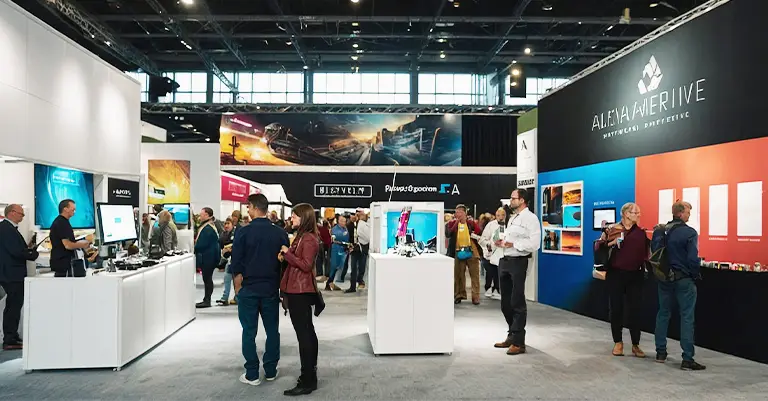Trade shows are events where businesses show off their new products, meet new people, and learn about the latest trends in their industry. This article will give you tips on how to navigate a trade show, from getting ready before the event to following up with people afterward.
Understanding Trade Shows
Trade shows are important because they bring together companies, professionals, and customers all in one place. They’re a chance to grow, learn, and work together. Knowing what trade shows are all about can help you improve at these events.
The Purpose of Trade Shows
The main goal of trade shows is to give companies a place to show off their newest products and services, meet possible clients and partners, and check out their competitors. They’re a great chance for businesses to get more known, find new leads, and make sales. Besides selling stuff, trade shows are places where people can learn a lot. They have many workshops, talks, and presentations by experts in the industry. This mix of marketing, meeting new people, and learning is vital to a company’s growth.
Types of Trade Shows
Trade shows can vary widely in focus and scale, catering to different industries and interests:
- Industry-Specific Trade Shows: These are tailored to specific sectors, such as technology, healthcare, fashion, or automotive, allowing businesses to target a niche audience.
- Consumer Trade Shows: Open to the public, these events are ideal for companies looking to directly engage with consumers, showcase products, and gather feedback.
- B2B Trade Shows: Designed for business-to-business interactions, these trade shows are where companies can form partnerships, understand industry trends, and discover business solutions.
- International Trade Shows: With a global audience, these events offer a broader perspective on industry trends, exposing businesses to international markets and diverse networking opportunities.
Each type of trade show offers unique benefits and challenges, and selecting the right one can significantly impact the success of your participation.
Pre-Trade Show Preparation
Success at a trade show begins long before you step onto the exhibition floor. The preparation phase is crucial for maximizing the opportunities these events offer. From setting clear objectives to packing the essentials, every detail matters in ensuring a productive experience.

Setting Clear Objectives
Defining what you aim to achieve before diving into the hustle and bustle of a trade show is essential. Objectives can range from launching a new product, generating leads, and networking with industry peers to gauging the competition. Clear goals will guide your activities during the event and provide a metric for evaluating success afterward.
Research
Thorough research is the backbone of adequate trade show preparation. Start by studying the event’s layout, exhibitor list, and schedule of workshops or seminars. Identify key players you want to meet and topics crucial for your business. Understanding the event’s dynamics will help you prioritize your time and efforts.
Planning Your Schedule
With your objectives and research, it’s time to plan your schedule. Allocate time for visiting specific booths, attending seminars, and networking sessions. Be sure to include buffer time for spontaneous meetings or extended discussions. A well-planned schedule ensures you cover essential ground without feeling overwhelmed.
What to Pack
Packing for a trade show goes beyond business cards and brochures. Consider these essentials:
- Promotional Materials: Ensure you have enough brochures, flyers, and business cards to distribute. If you’re exhibiting, branded giveaways can attract visitors to your booth.
- Digital Devices: A smartphone or tablet with a portable charger will keep you connected and allow quick information sharing or note-taking.
- Comfortable Attire: Wear comfortable shoes and professional attire suitable for long days on your feet.
- Health Essentials: Hand sanitizer, water, and snacks will keep you energized and healthy throughout the event.
Preparation is critical to navigating a trade show effectively. By setting clear objectives, conducting thorough research, planning your schedule, and packing wisely, you’re setting the stage for a successful and rewarding experience.
At the Trade Show
Once you arrive at the trade show, the real work—and fun—begins. Navigating the floor efficiently and employing effective networking strategies are crucial to maximizing your trade show experience. Here’s how to tackle each aspect with confidence.

Navigating the Floor
The trade show floor can be overwhelming with its maze of booths, exhibits, and crowds of attendees. A strategic approach to navigation can help you make the most of your time.
Using the Map
Most trade shows offer a map on paper or in an app. Before you start exploring, take a look at the map. Find the booths you want to see based on your research and determine the best way to visit them. It’s also smart to mark where the bathrooms, food areas, and emergency exits are.
Prioritizing Exhibits
With the map ready, decide which booths to visit first based on what you want to achieve. If you’re looking for new products, go to the areas with new inventions or startups. If you want to network, find out where the important companies are and visit them when it’s quieter. Being flexible is important; be prepared to change your plan if you find new opportunities.
Networking Strategies
Trade shows are prime networking opportunities, but the sheer number of attendees can make it challenging to connect meaningfully. Here’s how to navigate networking:
Elevator Pitch
Prepare a concise, compelling elevator pitch that introduces who you are, what you do, and what you’re looking for at the trade show. Your pitch should be adaptable, allowing you to emphasize different aspects depending on the listener. Practice it until it feels natural.
Collecting Contacts
Networking means making real friends, not just trading business cards. Talk freely, ask about their work, and share your ideas. Use an app or something to keep track of people you meet. Send them a message later about something interesting you talked about. To do well at a trade show, use the map wisely, choose the best booths to visit, be ready with a quick intro, and gather contact details carefully. Doing these things will help you meet your goals at the trade show.
Maximizing Your Trade Show Experience
Attending a trade show is more than just networking on the exhibition floor. To maximize your experience, engaging deeply with the content offered, from workshops and seminars to interactive exhibitor demonstrations, is essential. Here’s how to ensure you leave the trade show enriched and informed.

Attending Workshops and Seminars
Trade shows often feature a lineup of workshops and seminars by industry experts. These sessions can provide valuable insights into market trends, new technologies, and best practices. To make the most of these opportunities:
- Select Relevant Sessions: Before the event, review the schedule and identify sessions that align with your objectives. Look for topics that fill gaps in your knowledge or offer a fresh perspective on your industry.
- Participate Actively: Don’t just be a passive listener. Engage with the content by asking questions, taking notes, and participating in discussions. This active involvement can deepen your understanding and make the session more memorable.
- Network with Speakers: Speakers at these sessions often lead thinkers in their fields. Take the opportunity to introduce yourself after their presentation, ask follow-up questions, or even exchange contact information for future correspondence.
Engaging with Exhibitors
The exhibitors at a trade show are not just there to sell their products or services; they’re a valuable source of industry knowledge and insights.
Asking the Right Questions
When engaging with exhibitors, asking questions beyond the surface is crucial. Instead of just asking about product features or pricing, inquire about industry trends, challenges they’ve overcome, or case studies of their solutions. This approach can provide deeper insights into the industry and potential solutions for your business.
Demonstrations and Samples
At trade shows, many booths show off their products live or give away free samples. Try these to see how the products work. You can ask any questions you have right there. Take samples if you can; they’re good for looking back on or might give you ideas.
To really benefit from a trade show, get involved and meet people. Pick the right workshops and talks, talk to the people at the booths, and make sure to check out the demos and take samples. This way, you’ll learn a lot, meet new people, and find great ideas to help your business grow.
Post-Trade Show Strategy
The conclusion of a trade show doesn’t signify the end of your efforts; instead, it marks the beginning of a critical phase where the connections made and information gathered are transformed into actionable strategies. A well-organized post-trade show plan is essential for capitalizing on the event’s opportunities and ensuring your time and resources are well spent.

Organizing Contacts and Information
After the hustle and bustle of the trade show, you’ll likely return with a wealth of contacts and information. Here’s how to manage this bounty:
- Digitize and Categorize: Convert business cards and notes into a digital format using a CRM system or a spreadsheet. Categorize these contacts based on potential (e.g., leads, partners, suppliers) and urgency of follow-up.
- Review and Reflect: Review your notes from workshops, seminars, and conversations. Highlight key takeaways, insights, and action points that can benefit your business.
- Share with Your Team: Compile the organized information into a report or presentation for your team. Sharing insights and potential leads with relevant departments ensures that valuable trade show learnings are disseminated throughout your organization.
Follow-Up Plan
A strategic follow-up plan is crucial for maintaining the momentum of the connections made during the trade show. Here’s how to approach it:
- Prioritize Your Contacts: Identify which contacts warrant immediate follow-up based on your initial categorization. These might include hot leads, potential partners, or influencers who can amplify your brand.
- Personalize Your Communication: Craft personalized messages for each contact, referencing specific conversations or moments from the trade show. This personal touch can significantly increase your response rate.
- Offer Value in Follow-Up: Instead of a generic sales pitch, offer value in your follow-up. This could be an insightful article, a solution to a problem discussed, or an invitation to a webinar. The goal is to continue the conversation, not close a sale immediately.
- Set Reminders for Regular Check-Ins: Building relationships takes time. Set reminders for periodic check-ins to keep the conversation going and stay top of mind with your new contacts.
Implementing a thorough post-trade show strategy by organizing contacts and information and then following up thoughtfully can significantly enhance the ROI of your trade show participation. This phase is crucial for turning potential leads into lasting business relationships and leveraging the full spectrum of opportunities presented by the trade show.
Digital Tools for Trade Show Success
In today’s digital world, using technology is key to making the most of trade shows. Digital tools can make planning, networking, and follow-up smoother, improve interactions, and help you benefit fully from each event. Here are some important apps, software, and social media tips to boost your success at trade shows.

Apps and Software
- Event Apps: Many trade shows now offer official apps with event maps, schedules, and exhibitor details. These apps can also facilitate networking by allowing you to connect with other attendees and set up meetings.
- Contact Management Apps: Apps like CamCard or Evernote can help you quickly digitize business cards and take notes, ensuring you keep track of every new contact efficiently.
- Scheduling Tools: Tools like Calendly or Doodle can simplify arranging meetings during the trade show, allowing you to maximize your time.
- Social Media Management Tools: Platforms like Hootsuite or Buffer can help you schedule posts, track mentions of the trade show, and engage with attendees in real-time, even when you’re busy on the show floor.
Social Media Strategies
- Pre-Show Buzz: Use social media to announce your attendance and build excitement about what you’ll be showcasing. Engage with the official trade show hashtag, share your booth number, and tease any product launches or demos.
- Live Updates: During the event, share live updates, photos, and videos to capture the energy of the trade show and your participation. This can include highlights from sessions you attend, key takeaways, or exciting exhibits.
- Engage with Other Attendees: Social media is an excellent platform for engaging with other trade show attendees. Comment on their posts, share your insights, and use the event’s hashtag to join broader conversations.
- Post-Show Reflections: After the event, share your reflections, learnings, and shoutouts to new connections made during the trade show. This solidifies relationships and positions you as an active industry participant.
Integrating these digital tools and social media strategies into your trade show plan can enhance visibility, streamline your experience, and foster meaningful connections during and after the event. Technology can amplify your trade show success and provide a competitive edge in your industry engagements when used effectively.
Common Mistakes to Avoid
Maximizing your trade show experience hinges on avoiding common pitfalls that undermine your efforts. Here are five crucial mistakes to steer clear of:

- Lack of Preparation: Arriving without a plan is a recipe for missed opportunities. Research the event, know which booths to visit, and have a clear networking strategy.
- Inadequate Follow-Up: The real work begins after the trade show. Failing to follow up with new contacts can nullify your networking efforts. Prioritize post-event communication to foster these budding relationships.
- Ignoring Digital Engagement: Your online presence during the trade show is vital. Neglecting to update social media or engage with the event’s digital channels can significantly limit your visibility and opportunities for engagement.
- Overemphasis on Sales: While generating leads is essential, an overly sales-focused approach can deter potential connections. Aim to build genuine relationships and understand the needs of others for more meaningful interactions.
- Skipping Educational Content: The workshops and seminars at trade shows offer invaluable insights. Overlooking these learning opportunities in favor of more time on the exhibition floor can mean missing out on key industry trends and knowledge.
By focusing on these areas, you can avoid common missteps and ensure a more productive, engaging, and successful trade show experience.
Closing Thoughts
Doing well at trade shows means preparing, engaging, and following up carefully. It’s essential to know the event well, make the most of being there, use digital tools, and avoid common mistakes to make these events help your business grow. Trade shows are great for learning, meeting people, and finding business opportunities. You can use these events to boost your business if you have a clear plan and aim to make real connections. Success at trade shows isn’t just about what you do there but also how you use what you learned and who you meet later.




